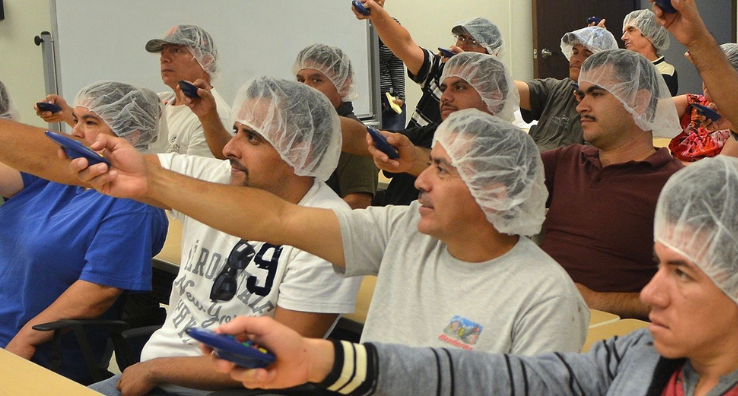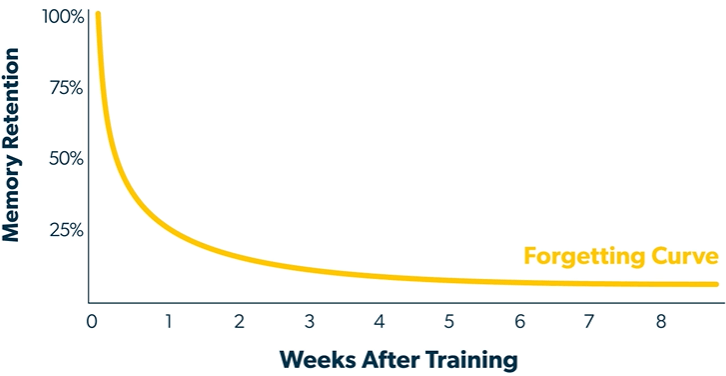4 Techniques to Make Training Stick and End the Forgetting Curve

High-quality, consistent employee training can do wonders for keeping foods and employees safe. Unfortunately, much of that training can go in one ear and out the other.
It’s a common belief among cognitive scientists, psychologists, and adult learning content creators that nearly 75% of training is forgotten within a week. This principle dates back to the 1880s when Herman Ebbinghouse introduced the Ebbinghouse forgetting curve, showing how quickly we forget information over time if we do not attempt to retain it.
But fret not, for there are proven ways to reverse the forgetting curve. First and foremost, one-and-done training alone isn’t enough. To be truly effective, employee training must be constantly reinforced with fresh, relevant content that is always top of mind.
Thankfully, the concepts that can reverse this forgetting curve are as simple as the concept itself. These four proven methods can help slow or reverse the forgetting curve and make your training more memorable.
High-quality Initial Training to Reduce the Forgetting Curve
Step one starts with, well, step one: the content and delivery of the initial training matters can make a lasting impression if done correctly. Deliver high-quality training content that follows adult-learning principles and includes frequent engagement points.
During the initial training process, companies are often eager to get employees on the floor as quickly as possible. That’s when massive amounts of information are unloaded on new employees in the shortest amount of time. It’s a perfect environment for the forgetting curve, as employees forget much of what they’re taught within their first few days.
To help overcome this learning deficit, take the time to explain why their training is important. During workplace safety training sessions, explain the consequences of not following safety measures in terms they’ll understand. For example, don’t preach about avoiding a back injury that can sideline them for work. Instead, talk about how long it takes to recover from an injury and how it might impact their ability to play with their kids or enjoy other personal activities.

When it comes to food safety, reinforce that the foods they produce at work are put on the table for friends and loved ones at home. Explain how food poisoning can result in illnesses and deaths.
Initial training can also be strengthened by offering content in short “microbursts” introducing one concept at a time, making it easier to digest information in smaller bites. These concepts should be frequently repeated throughout training.
Questions and quizzes can keep employees engaged throughout the training process, enabling trainers to immediately remedy incorrect answers.
Real-world scenarios and site-specific imagery can make training relatable for trainees. Seeing their environments and real situations in training materials can make a huge difference in retaining information.
According to the Global Food Safety Training Survey, companies that utilize site-specific imagery in their safety training reported that their employees adhere to established protocols 52% more often than companies that do not. And they were much more confident their employees could identify potential risks and take action accordingly.
Much of this training content can be developed by third parties. However, it is essential that content can be customized and easily edited to include site-specific content and scenarios.
Applied Learning to Take Training from Theoretical to Real Life Scenarios
The next step to reducing the forgetting curve is to apply your training content to your work environment. This method, also known as “learn by doing,” reinforces training content through multiple methods. You can apply training content to real work scenarios and follow up with on-the-floor observations to ensure training is understood and implemented properly. This will help validate processes to improve accuracy, consistency, and proper documentation.
One way to apply training is to pair employees with approved trainers to reinforce instructions and behaviors and show them exactly what to emulate.
Passive Training for Always-on Reminders
Booster events can help reverse the forgetting curve when spaced out over time. Many of these come as “always-on” reminders that run in the background, like posters, table tents, and video displays.

Passive training tools like posters can be effective, inexpensive, and easy to use. But like other training materials, they should be relevant and unique to your employees. Rather than simply warning employees not to do something over a poster, find a way to make it relatable and impactful.
For example, instead of having a poster telling employees to “bend at the knees,” show a worker suffering from a back injury who is unable to play with their kids at home. Again, this offers the “why” behind safety training.
Keep your signage fresh and updated. If you leave the same sign or poster up too long, employees will stop noticing it.
Communication stations and video monitors throughout buildings and the breakroom are an excellent way to keep content fresh. You don’t have to produce videos; instead, you can loop slides with photos and updated messages. You can also use these stations to celebrate employees who follow training measures. This minimal effort can have a big return.
Active Reinforcement Training to Keep Training Top of Mind
Direct active training reinforcement is probably the highest impact “booster event” you can leverage for your training.
This can come in the form of refresher training courses to identify critical topics that require intermittent formal refreshers. These sessions are generally shorter than initial training programs and can use the same visuals, graphics, and scenarios to assist recall and retention.
Follow up refresher training with floor observations for supervisors to provide prescriptive corrective actions or positive reinforcement when available. Good luck with your training reinforcement efforts! If you would like help, Intertek Alchemy provides solutions for all four training techniques we’ve reviewed. Please don’t hesitate to contact us for more information.





